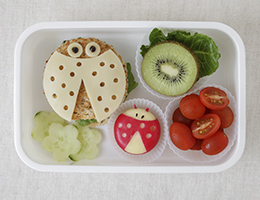
Do you often pack a school lunch, only to unpack it barely touched? Then here's a six-step recipe from the Academy of Nutrition and Dietetics and other experts for healthy lunches your child will actually eat and enjoy.
1. Know the building blocks. To help your child grow and learn, every lunch needs:
- Some protein. Choose low-fat options, such as lean meats or plant-based proteins like nuts and legumes.
- A grain. Go for whole grains like whole-wheat bread, brown rice or plain popcorn.
- At least one fruit and one veggie.
- A calcium-rich food or drink. That could be a fat-free or low-fat dairy product—or if your child doesn't do dairy, fortified almond or soy milk.
2. Give your child a say. Fussy eaters are more likely to gobble up food they helped pick out. So at the grocery store or farmers market, help your child choose among nutritious food options.
At home, your child can also help pack or fix their lunch the night before. That's another way to encourage them to actually eat what they packed—rather than toss or trade it.
3. Switch it up. A healthy diet has variety. That doesn't mean you have to fret if your child plays favorites. That's normal pickiness. But do come up with a list of alternatives to the same old standards. For example, if your child is stuck in a PB and J rut, you might try different sandwich fillings such as:
- Hummus and cherry tomatoes.
- Tuna or chicken salad made with low-fat mayo, topped with shredded carrots, baby spinach or sliced peppers.
- Almond or cashew butter and sliced apples.
- Sliced turkey with baby spinach and reduced-fat cheese.
You can switch things up on the outside too. Stuff sandwich fillings in whole-wheat pitas, bagels or tortillas. Or build a bread-free sandwich—for example, wrap a slice of roast beef around a low-fat cheese stick.
Consider alternatives to the sandwich too. Pack a salad with protein, such as cheese, nuts or beans. And don't overlook leftovers like last night's spaghetti, roast chicken, or rice and bean casserole. You can use a thermos or cold pack to help keep foods at the right temperature.
4. Play up produce. To add to the appeal of fruits and veggies, make them fun: Thread chunks of your child's favorite fruits on skewers for kebabs. Include dipping options, like salsa, low-fat dressing or yogurt. And go for finger foods, like seedless grapes or easy-to-peel clementines. And remember: You can always sneak sliced or shredded veggies into sandwiches and wraps.
5. Think about drinks. Buying milk at school is an easy way for kids to get the calcium they need. But there's nothing wrong with water either, as long as you pack another source of calcium, such as yogurt, string cheese, or fortified cereal and soy milk. As for fruit juice—even 100%—go easy. Whole fruits are a better choice most of the time. They offer more fiber and other nutrients.
6. Be snack-smart. No food has to be off limits—that can backfire and make sugary or fatty foods more desirable. But try to keep lunch box extras small and as nourishing as possible—some dried fruit or baked veggie chips, for example.
Eating cafeteria-style
While packing lunches gives you more control over what your child eats, the school cafeteria can be a convenient and nutritious alternative.
And compared to meals you might have been served in your own school days, today's cafeterias are dishing up more produce and grains, more vegetarian dishes, more low-fat dairy products and fewer fried foods.
That means your child's school may serve foods like veggies and dip, low-fat yogurt parfaits with fruit, oven-baked fish nuggets and even bean burgers. Take a look at the menus ahead of time so you can encourage your child to make healthy choices.
A final tip: Whether lunch came from home or the cafeteria, ask how it was. It's a chance to reinforce good decisions, get input on next week's menus and start talking about your child's day.
Reviewed 3/6/2025
Sources
- American Heart Association. "Food Sources of 5 Important Nutrients for Vegetarians." https://www.eatright.org/health/wellness/vegetarian-and-plant-based/food-sources-of-5-important-nutrients-for-vegetarians.
- American Heart Association. "Meal Planning: How to Pack a Healthy School Lunch." https://www.heart.org/en/healthy-living/healthy-eating/cooking-skills/meal-planning/meal-planning-how-to-pack-a-healthy-school-lunch.
- EatRight.org. "Banishing Brown Bag Boredom." https://www.eatright.org/food/planning/away-from-home/banishing-brown-bag-boredom.
- EatRight.org. "Get to Know Your School Lunch Program." https://www.eatright.org/food/planning/away-from-home/get-to-know-your-school-lunch-program.
- HealthyChildren.org. "Fruit Juice and Your Child’s Diet." https://www.healthychildren.org/English/healthy-living/nutrition/Pages/Fruit-Juice-and-Your-Childs-Diet.aspx.
- HealthyChildren.org. "Juice Boxes: Tips for Parents." https://www.healthychildren.org/English/healthy-living/nutrition/Pages/Juice-Boxes.aspx.
- National Heart, Lung, and Blood Institute. "Healthy Cooking and Snacking." https://www.nhlbi.nih.gov/health/educational/wecan/eat-right/healthy-cooking.htm.
- National Institute of Diabetes and Digestive and Kidney Diseases. "Helping Your Child: Tips for Parents and Other Caregivers." https://www.niddk.nih.gov/health-information/weight-management/healthy-eating-physical-activity-for-life/helping-your-child-tips-for-parents.
- U.S. Department of Agriculture Food and Nutrition Service. "MyPlate Guide to School Lunch." https://myplate-prod.azureedge.us/sites/default/files/2020-12/School%20Lunch%20%282016%29.pdf.